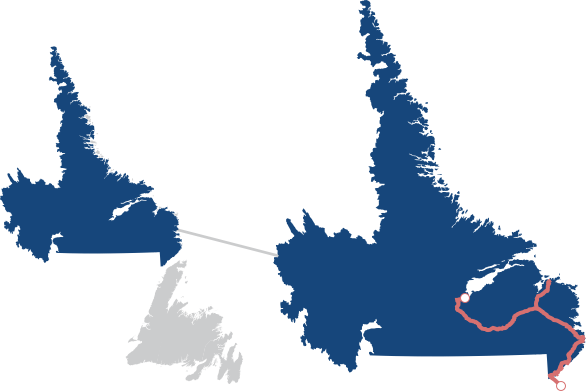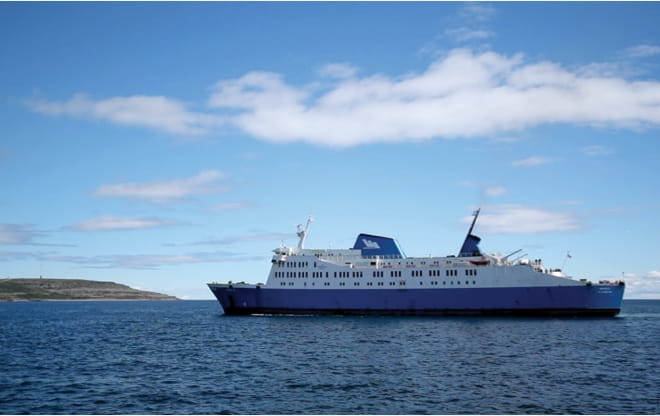 See whales and seabirds from the year-round ferry between St. Barbe and Blanc Sablon.
See whales and seabirds from the year-round ferry between St. Barbe and Blanc Sablon.
Take the ferry ride across the Strait of Belle Isle to Blanc Sablon on the Labrador-Québec boundary. The
year-round ferry, that takes passengers and a limited number of vehicles, is a great way to see whales and
seabirds.
When travelling by Labrador Marine ferry, it's important to plan in advance. Schedules can vary and there are time
zone changes. When you board the ferry in St. Barbe, you’re on Newfoundland Time, but once you arrive in Quebec,
you’ll find yourself on Atlantic Standard Time. Then, as you drive further east into Labrador, you’ll cross time
zones again back into the Newfoundland Time Zone (the communities south of Black Tickle are on Newfoundland Time).
1-866-535-2567 (within Newfoundland and Labrador) 1-709-535-0810 (outside the province) http://www.labradormarine.com. If
flying into Quebec, the Blanc Sablon airport schedule operates on Atlantic Standard Time.
Cellphone service is limited on the Trans-Labrador Highway, so before hitting the road, borrow a satellite phone
to make sure your scenic drive is a safe one. Click here for a list of locations.
It’s a short drive from Blanc Sablon to L’Anse au Clair, the beginning of Route 510 on the Québec-Labrador
Highway, also known as Expedition 51°. As you travel east into L’Anse au Clair, you will enter Newfoundland Time
Zone.
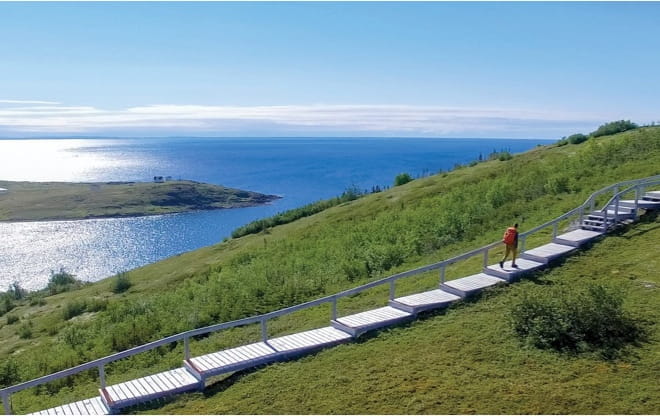 There are hiking trails through the Expedition 51 Road Trip that will take you along the coast, over sand dunes
and boardwalks, and to historic landmarks like resettled communities and a UNESCO World Heritage Site.
There are hiking trails through the Expedition 51 Road Trip that will take you along the coast, over sand dunes
and boardwalks, and to historic landmarks like resettled communities and a UNESCO World Heritage Site.
This area has thousands of years of Indigenous history. French Settlers arrived in L’Anse au Clair in the early
1700s to fish off the coast – today, it remains a picturesque fishing village. The Gateway to Labrador Centre,
which is a restored church, has displays on the history and heritage of the area, and information on what to see
and do. Just a few steps away, you can take a stroll on a beautiful sandy beach. Nearby, the Jersey Trail leads to
an interpretation area on Jerseymen from the Channel Islands who fished here in the 19th century. This trail is
also the start of the Labrador Pioneer Footpath that winds north along the coast of the Labrador Straits to
Pinware, connecting seven communities over 110 kilometres. Prior to roads, these traditional footpaths were an
essential link between communities.
Along the Forteau River during the months of July and August, trout and salmon anglers should be
prepared to meet
their match on the many pools, steadies, and rattles. If you’re a non-resident, you’ll need to hire a guide.
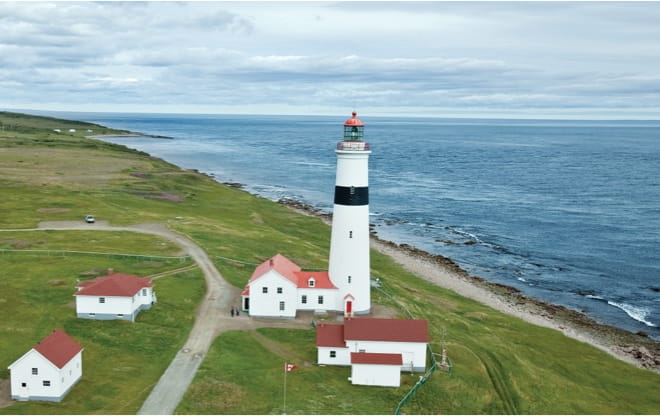 Climb the tallest lighthouse in Atlantic Canada in Point Amour.
Climb the tallest lighthouse in Atlantic Canada in Point Amour.
North on the highway is L’Anse Amour National Historic Site, where you will find the oldest known burial mound in
North America, dating back 7,500 years ago. Archaeologists have discovered campsites of the Maritime Archaic
people along the coast, as well as those of Pre-Inuit and later Indigenous groups.
Point Amour has the tallest lighthouse in Atlantic Canada. Built in 1855, it rises 109 feet to aid navigation
through the sometimes-treacherous Strait of Belle Isle between Newfoundland and Labrador. This Provincial Historic
Site is a gem. An interpreter will guide you up the steps and ladders to the top for a magnificent view – keep
your eyes peeled for icebergs, seabirds, or breaching whales – while the lower-floor displays are both imaginative
and informative. Back on solid hike the coastal trail or picnic on the sandy beach.
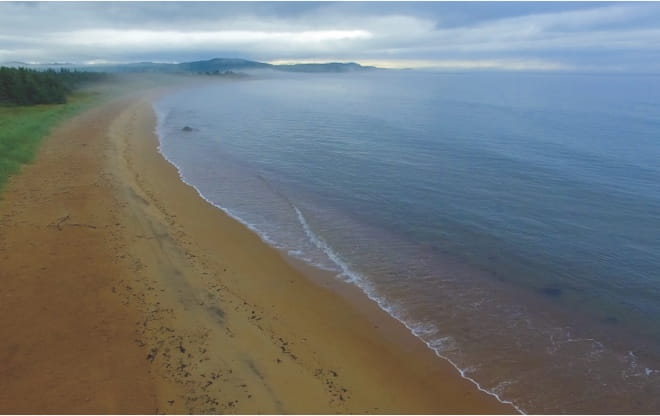 Walk the beautiful stretch of sandy beach hugging the Strait of Belle Isle in Pinware Provincial Park.
Walk the beautiful stretch of sandy beach hugging the Strait of Belle Isle in Pinware Provincial Park.
Further along this route is Pinware Provincial Park, known for its beautiful stretch of sandy beach hugging the
Strait of Belle Isle. This park is also home to the mighty Pinware River – another popular spot for trout and
salmon anglers. Interesting fact: the community of Pinware has the oldest known Indigenous site in the province
dates back almost 9,000 years ago.
Red Bay is a UNESCO
World Heritage Site and tells the intriguing story of 16th-century Basque whalers. They built
the first major industrial complex in the New World here, and hunted whales for rendering into oil to light the
lamps of Europe. The Basques left here in the early 1600s and were forgotten until researcher Selma Barkham found
their records in Spanish archives. Before the Basque were here, Indigenous groups occupied the land for thousands
of years.
On Saddle Island are the remnants of the tryworks and other facilities, a two-minute boat ride away. The remains
of 130 men who perished here, and the red roof tiles that covered their dwellings, populate this beautiful,
historic landscape.
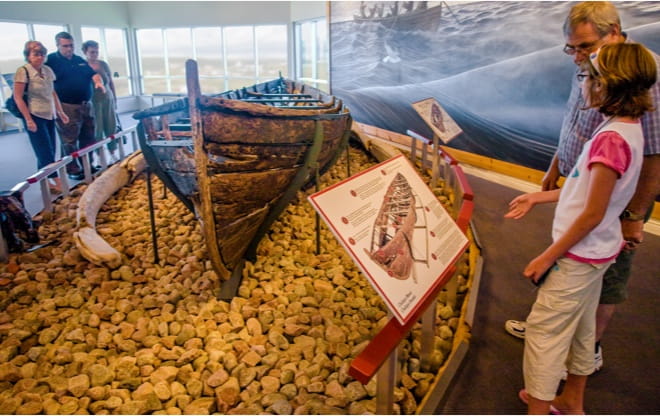 Visit the Red Bay UNESCO World Heritage Site interpretation centre to see the preserved remnants of a chalupa, or
shallop, the small boat used by whalers to chase down their quarry.
Visit the Red Bay UNESCO World Heritage Site interpretation centre to see the preserved remnants of a chalupa, or
shallop, the small boat used by whalers to chase down their quarry.
The interpretation centre contains the preserved remnants of a chalupa, or shallop, the small boat used by whalers
to chase down their quarry. During the excavation of the site, underwater archaeologists from Parks Canada found a
wreck, believed to be the San Juan, which sank here with a full cargo of oil in 1565. In Mary’s Harbour, catch the
ferry to Battle
Harbour – a picturesque fishing port established in the 1750s. This unique village is frozen in
time, with virtually no signs of modern life, and you can stay in a one-of-a-kind inn. It’s a trip into the past
that is truly a restorative experience and begs a two-night stay to be truly appreciated. Tour the late
18th-century buildings and the surrounding area; this National Historic Site and District is the best-preserved
traditional fishing village in the province. If it’s a clear evening, look for the incredible northern lights,
which are visible in Labrador about 240 nights a year.
Next, consider a side trip to Port Hope Simpson and Cartwright. In Port Hope Simpson, relax in the town or arrange
to fish on Shinney's River with local guides. Depending on the time of your visit and water conditions, you may be
angling for a feisty sea-run brook trout or the king of the game fish, an Atlantic salmon. You can also visit the
ancestral homes and resettled fishing villages of the Labrador coast where you’ll enjoy a fresh mussel harvest and
boil up, or you can learn the traditional cold-smoked methods of curing char with Labrador blackberry bush.
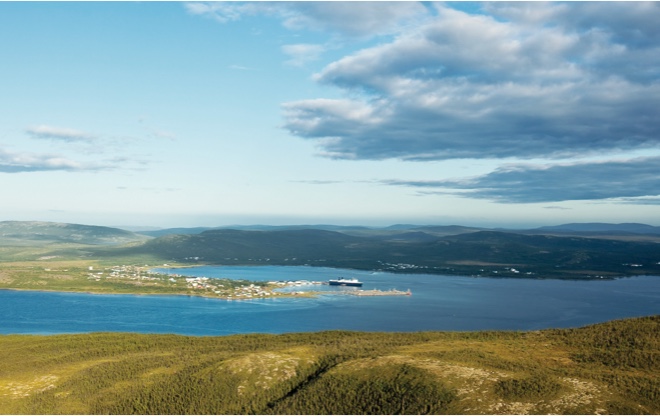 Explore the community of Cartwright, meet the locals and check out Flagstaff Hill.
Explore the community of Cartwright, meet the locals and check out Flagstaff Hill.
Upon arrival in Cartwright, meet the locals, explore the community, and check out Flagstaff Hill. Cartwright is on
the doorstep of the recently established Akami-Uapishkᵁ-KakKasuak-Mealy Mountains National Park Reserve, the
largest national park in eastern Canada at 10,700 square kilometres. While there are currently no visitor offers
in the park yet, Parks Canada has opened an office in Cartwright. Drop by, meet the team, and plan your potential
future adventures.
The longest leg of this expedition is between Cartwright and Happy Valley-Goose Bay. Allow a half-day for the
drive along this mostly paved road.
Road Trip Tips:
Please check exact directions and road conditions before you start each road trip. Visit www.511nl.ca for current
road conditions and ferry updates.
This road trip includes a community(s) accessible by a provincially operated ferry from St. Barbe to Blanc Sablon.
Please visit www.tw.gov.nl.ca/ferryservices/schedules for routes and rates. Some ferries do permit vehicles, with
a set limit for vehicle capacity; other ferries are passengers only (no vehicles accepted) so plan accordingly.
For information on the Battle Harbour ferry, visit https://battleharbour.com.
Distances are estimates and for guidance only. Routes can be taken as is, or in reverse order.

